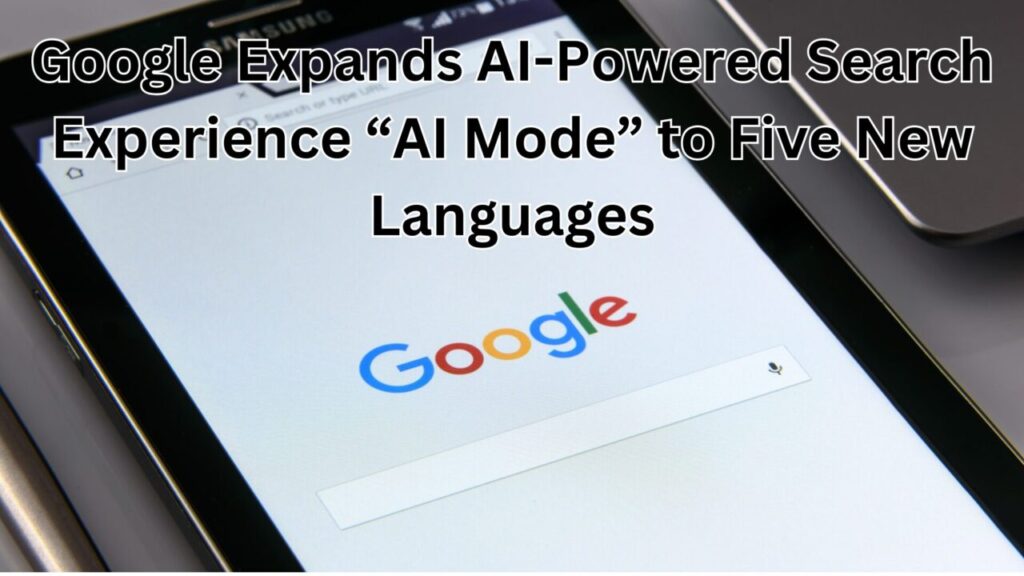
Google is taking a big step in its AI-driven search journey by expanding its AI Mode to more users worldwide. Until recently, the feature was limited to English, but starting this week, it will support Hindi, Indonesian, Japanese, Korean, and Brazilian Portuguese.
This move aims to make AI-powered search more inclusive, allowing millions of new users to access advanced search features in their preferred local language.
Also Read : The Future is Wearable: How AI-Powered Devices Are Personalizing Healthcare for Indians.
Table of Contents
Google Search AI Updates: Breaking Language Barriers
Google officially announced the update on Monday. According to Hema Budaraju, VP of Product Management at Google Search, this expansion means users can now:
Ask complex questions in their native language.
Explore the web with deeper context and richer results.
Get more natural, conversation-style responses.
The timing is also important. Just last month, Google rolled out the AI-powered search experience in 180 new markets, but only in English. The addition of these five languages makes the feature far more global.
What Exactly Is Google’s AI Mode?
Launched earlier this year as part of an experimental rollout for Google One AI Premium subscribers, AI Mode is essentially Google’s answer to AI search competitors like Perplexity and OpenAI’s ChatGPT Search.
At its core, it is powered by a customized version of Gemini 2.5, which comes with multimodal and advanced reasoning capabilities. That means it doesn’t just process text—it can understand and integrate images, context, and complex user queries into more intelligent answers.
For now, users can access AI Mode through:
A dedicated tab on the search results page.
A button integrated in the search bar.
But according to Logan Kilpatrick, Group Product Manager at Google DeepMind, Google may soon make AI Mode the default search experience.
Going Beyond Search: Agentic Features
In August, Google added another layer of intelligence to AI Mode by introducing agentic features. These capabilities go beyond information retrieval, enabling real-world actions like:
Restaurant bookings.
Future support for local service appointments.
Event ticket bookings (currently under development).
However, these advanced features are still limited. At present, they are only available in the U.S. to Google AI Ultra subscribers, who pay a premium of $249.99 per month for the top-tier AI access.
AI Mode vs. Website Traffic Concerns
While Google is pushing aggressively into AI-powered search, not everyone is thrilled. Publishers and content creators worry that AI-generated overviews and direct answers could reduce website clicks.
Google, however, has denied claims that its AI search features are killing traffic. The company insists that AI Mode is designed to enhance user experience, not to cut off the ecosystem of websites that make the internet valuable.
Also Read : Publishers Confront Existential Threat from Google’s AI Search Features
Why This Expansion Matters
This expansion is more than just a language update—it signals Google’s commitment to making AI search globally accessible.
For users, it means they can now ask questions in their own language without switching to English.
For Google, it strengthens its position in the ongoing AI search race against OpenAI and Perplexity.
For businesses and content creators, it’s a reminder to adapt strategies for AI-augmented search visibility.
Final Thoughts
With AI Mode now available in five additional languages, Google is clearly accelerating its vision of transforming search into a conversation-driven, action-oriented experience.
The question is no longer whether AI will change search—but how quickly it will become the default way we interact with the web.
Key Takeaway: Google’s AI Mode is no longer just for English speakers. By supporting Hindi, Indonesian, Japanese, Korean, and Brazilian Portuguese, the company has opened the doors for millions of users to explore AI-powered search in a more natural, localized way.
Disclaimer: The information in this article is based on details first reported by official sources and publicly available news, including Google News. We have adapted and rewritten the content for clarity, SEO optimization, and reader experience. All trademarks and images belong to their respective owners.
